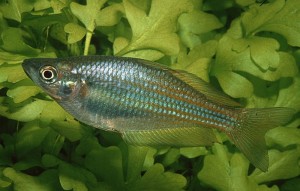The Eastern Rainbowfish (Melanotaenia splendida splendida) also known as the Splendid Rainbow, is widespread on mainland Australia and is be found in river systems east of the Great Dividing Range of Queensland, from the Boyne River south of Gladstone, to Cape York Peninsula. They are found in large schools in a variety of habitats that includes rivers, streams, swamps, and lagoons which are all subject to seasonal water level fluctuations, temperature changes, and changes in dissolved sediments. They are collected from underneath submerged logs, sunken trees and other debris, and from under densely grown banks and other aquatic vegetation that they use for cover.
The Eastern Rainbowfish, or Splendid Rainbow, is one of more than five subspecies of Melanotaenia splendida. They all have characteristically large eyes, a black or silver band that runs through the middle row of scales, two dorsal fins, and a deeply forked mouth.
Eastern Rainbowfish (Melanotaenia splendida splendida) display a huge assortment of naturally occurring color varieties and markings. There are several different subspecies of Melanotaenia splendida splendida that are not easily identified in relation to each other. The main differences are in the depth of their body and color patterns, which depend entirely on their natural environment and where they are located.
The basic body color of Eastern Rainbowfish is an overall pale bluish green, oliveish to yellowish, blending into white on the lower sides. Each horizontal row of scales is separated by a narrow orange to reddish stripe. Scales on the sides of their body are usually bluish green, yellowish red or purplish. The middle lateral stripe can change from black to a deep yellowish color towards the anterior and blueish green or brownish green on the caudal peduncle.
Some of the other common body stripes can be red, blue, yellow or green. The fish usually display an orange or yellow spot on the opercula. Their dorsal, caudal and anal fins can be a checkered red and yellow or orange yellow with bright red spots on their membranes with faint black edges.
There are other forms of Eastern Rainbowfish that have a blue green body with yellow green fins that have dark flecks and a dark border.
With all forms of rainbowfish, colors are extremely variable and are dependent on mood, diet, water conditions and age. Mature adult males are larger and more colorful than females. They also develop a deeper body than females, with longer dorsal and anal fins.
Eastern Rainbowfish are a peaceful shoaling species that will thrive in a densely planted aquarium with a sandy or fine gravel substrate, some river rock,
driftwood roots and plenty of swimming space. These fish do well in a single species aquarium with at least 6 or more of their own kind or in a peaceful community tank with other non-aggressive like sized species. The water should be acidic to slightly alkaline (pH 6.4 to 7.2) with a temperature range from 68-84 degrees F.
The Eastern Rainbowfish is an egg layer that spawns the year round, but most energetically during the Australia’s rainy season (November to May). In the wild, females will deposit one to three eggs at a time among plants along the side of the river or lake. In an aquarium environment, you can breed them by keeping a conditioned group in a breeding tank with a moss substrate or a nylon breeding mop or two and no substrate. The breeding aquarium should be at least 30 inches long with slightly hard, alkaline water at a pH of around 7.5, and a water temperature between 80 and 84°F. Provide a small air powered sponge filter for oxygenation, filtration, and mild water flow.
As courtship begins, select the plumpest female and most vividly colored male and keep them in the breeding tank. Raise the temperature slightly to stimulate spawning activity and the fish should commence spawning the next morning. The female will deposit her .05″ long eggs on the moss or breeding mop attached by a small thread. The pair will spawn for several weeks laying several batches of eggs (up to 200 eggs in two weeks) each day.
Although the parents will usually not eat their eggs, its easier to raise the fry without the parents in the breeding tank. Depending on the water temperature, the eggs will hatch in 7-14 days and the fry should be fed an omnivorous diet after they become free swimming and their egg sacs have been absorbed (usually 245 hours after hatching).
The fry are tiny and should be fed infusoria until they are able to eat baby brine shrimp (usually in a week or so).
Eastern Rainbowfish are omnivorous and should be fed a mixed diet of live, frozen, and freeze dried foods. An omnivore flake food should be the staple with occasional offerings of tubifex, bloodworms, brine shrimp, daphnia and vegetable matter.
Adult Eastern Rainbowfish are seldom available for sale. Drab colored juveniles are usually available for purchase at a size of 1-1/2″ to 2-3/4″.
Minimum Tank Size: 55 gallons
Care Level: Moderate
Temperament: Peaceful
Aquarium Hardiness: Hardy
Water Conditions: 68-84° F, KH 10-30, pH 6.4 to 7.2
Max. Size: 4”
Color Form: Silver, Yellow, Red
Diet: Omnivore
Compatibility: OK like size peaceful species
Origin: Northeast Australia
Family: Melanotaeniidae
Lifespan: 5 – 8 years
Aquarist Experience Level: Beginner





